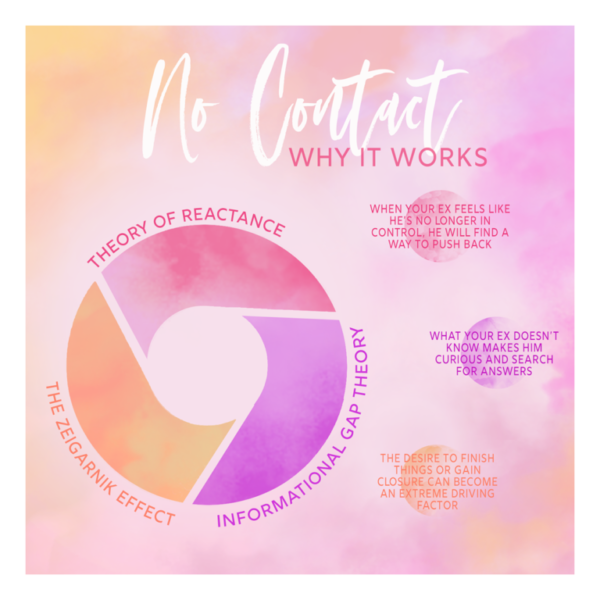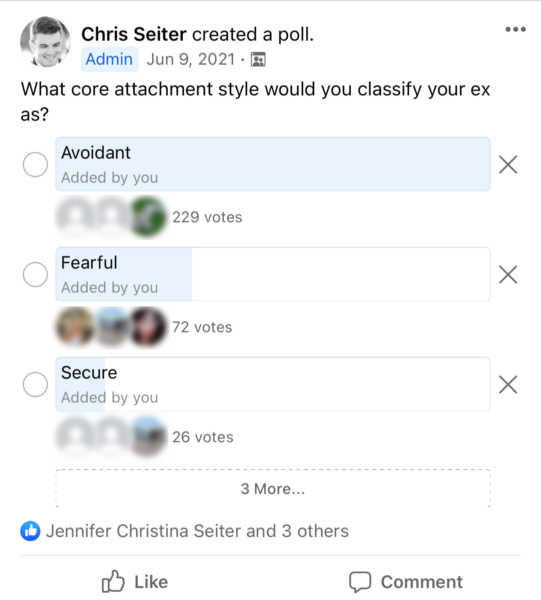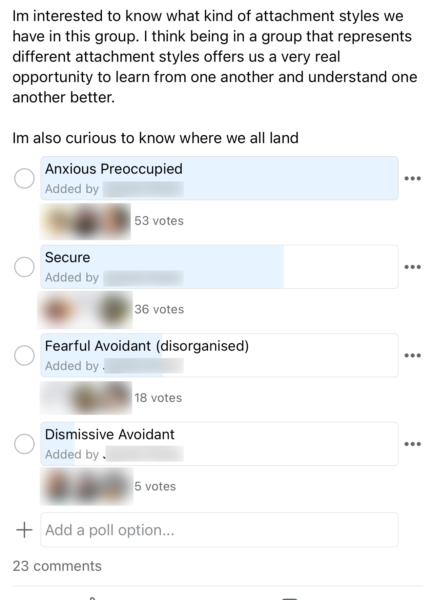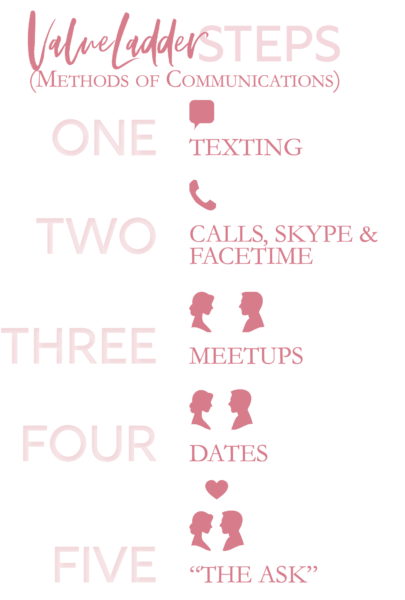This is a complete guide to fixing a relationship after taking a breakup.
In this in-depth guide, you’re going to learn the following:
- The Importance Of Using The No Contact Rule
- How To Take Steps To Work On Adopting A More Secure Attachment Style
- Getting To A Place Emotionally Where You Don’t Want Them Back Anymore
- Why You Should Adopt Our Value Ladder Concept
- Setting A Realistic Goal Of How Long This Process Takes
- The Work Doesn’t Actually Stop When You Get Them Back
- Understanding How To Speak Their Attachment Language
- Working On Rekindling Your Emotional Connection
Let’s dive right in!

What Are Your Chances of Getting Your Ex Boyfriend Back?
Take the quizUse The No Contact Rule
You might’ve heard of this rule before— it means you don’t contact your partner during the break.
It’s mentioned a lot on Ex Boyfriend Recovery because it’s essential to the healing process. And this rule has become one of the most effective ways to repair a relationship after taking a break.
The idea is that when you go on a break, your partner needs time to reflect and process what has happened between you two.
The “No Contact Rule” is a way of allowing that time without any further pressure.
To fully understand everything it entails, you can check here for the definitive guide to the No Contact Rule:
https://www.exboyfriendrecovery.com/the-no-contact-rule/
Or, if you’re not much for a long read, I recommend watching this video from our founder, Chris Seiter,
Going all in on the no-contact rule doesn’t mean you’ll ignore your ex forever; instead, it’s about taking time apart from your ex to heal yourself and adopting a more secure attachment style.
We’ll talk about that a little later in this article.
For now, let’s move on.
Take Steps To Work On Adopting A More Secure Attachment Style
As much as you want things to stay the same as before, it’s essential to understand that the same relationship dynamics won’t work after a break.
What made you take the break in the first place? It’ll allow you to understand and learn from what went wrong.
Our internal polls show exes of our clients tend to have an avoidant attachment style.
Meanwhile, our clients tend to fall into the anxiously attached category. And this isn’t healthy.

What Are Your Chances of Getting Your Ex Boyfriend Back?
Take the quizA study from Sage Journals mentioned that “attachment anxiety was positively associated with greater levels of romantic breakup grief”— this means that the more anxious a person is, the harder it’ll be for them to move on.
“The Root of Suffering is Attachment”
Therefore, working on having a secure attachment style is essential.
Luckily, our Ex-Boyfriend Recovery program teaches our clients to inhibit a secure attachment style by having a balanced approach to their relationship. Here are some research-based strategies for developing a more secure attachment style:
- Improve self-awareness: Recognize your attachment style and how it impacts your relationships. This awareness can help you understand and regulate your emotional responses, leading to more secure attachment behaviors.
- Develop healthy communication skills: Good communication is critical to building secure relationships. Practice active listening, express your thoughts and feelings clearly, and show empathy and understanding towards your partner.
- Cultivate trust: Trust is a crucial component of a secure attachment. Be trustworthy by keeping your promises, being reliable, and maintaining clear boundaries. Trust your partner by assuming the best intentions, being vulnerable, and communicating honestly.
- Practice emotional regulation: Emotions are a natural part of any relationship but can become overwhelming if not managed effectively. Learn to regulate your emotions through mindfulness, relaxation techniques, or seeking support from a therapist or counselor.
- Work on unresolved issues: Unresolved issues from past relationships or childhood experiences can impact your attachment style. Consider working with a therapist to explore and address these issues, so you can move towards a more secure attachment style.
Get To A Place Emotionally Where You Don’t Want Them Back Anymore
Understandably, you are still missing your ex, but try to think about the breakup objectively and use a logical approach.
When you have healed emotionally and come to terms with the changes that happened, it can be easier for you to let go and move on. Not to mention, our founder, Chris Seiter, believes that moving on might be the very best way to get them back anyways.
So, really getting to a place emotionally where you don’t want them back anymore can kill two birds with one stone.
In fact, part of the editorial guidelines requires one of the master coach/co-founders to look over every article published by staff writers like me.
I asked Chris to provide a quote to further back up this point.
Here it is,
Consistently whenever I interview success stories, a handful of trends emerge.
- They all use some form of no contact
- They are all at this place emotionally where they don’t want their ex back anymore.
Why does this work?
It has to do with the fact that most of our clients’ exes are avoidant, and avoidants are accessible to long for an ex once they are unavailable out of the relationship. Typically, they are out of contact, untouched by actual engagement.
It’s hard to see from a logical perspective when your emotions are still raw, and you’re in love with them until you can take a step back and see it from the outside.
When they do so, their deactivation systems aren’t triggered, revealing their long-suppressed attachment and switching their operating attachment wound from the fear of engulfment to the fear of abandonment.
There you have it from the man himself. Let’s move on.
Adopt Our Value Ladder Concept
At Ex Boyfriend Recovery, we use the value ladder concept.
The concept is simple— start by implementing a no-contact rule and increasing your self-value and worth so that you don’t rely on your ex to give you the affirmation and approval you seek.
After the no-contact rule, your first step is to rebuild value within the texting phase. This involves building trust, having meaningful conversations, and ensuring you don’t appear too desperate or needy.
If you’re wondering what these four methods of communication are, here’s a breakdown:
- Text Message-Based Communication – Any communication sent via Text, iMessage, WhatsApp, Instant Messaging
- Phone Call-Based Communication – Any conversation you have via a Phone, Video Chat, or Zoom session.
- In-Person Meetup-Based Communication – We move into the “in-person communication phase. Meetups aren’t considered dates. They aren’t regarded as romantic but they are meeting up in person
- In-Person Romantic-Based Communication – This is another type of in-person communication. Still, it’s a date where romance is assumed.
Sounds easy enough, right? Well, it’s not.

What Are Your Chances of Getting Your Ex Boyfriend Back?
Take the quizIt takes a conscious effort to stay on track with this value ladder concept and increase your value, which will help you gain the respect of yourself and your ex.
For a more detailed breakdown, check this out: https://www.exboyfriendrecovery.com/how-get-your-ex-boyfriend-back/#value-chain-value-ladder
Set A Realistic Goal Of How Long This Process Takes
Many of our clients are surprised at how long the process takes. Before getting started, it’s essential to set a realistic goal of how long it will take to rebuild your relationship.
The average length of most of our success stories is 5.2 months before reconnection occurs. This is NOT including the time before clients entered into our coaching program.
Rather it’s only counting from the following phases,
- no contact
- rebuilding value
- trust to getting your ex
But what does the research say about success rates?
From what reputable research we’ve found, the chances of getting your ex back without our help are 48.25% but clients of our master coaches are seeing a 70% success rate. So, it’s clear that getting your ex back can take some time and effort but having a professional guide you along the way can make a world of difference
Of course, that can go earlier, depending on how you manage your emotions and your ex’s willingness to come back.
Set a realistic timeline, manage expectations, and be patient.
The Work Doesn’t Stop When You Get Them Back
You’re mistaken if you think the change you’ll be making ends after getting them back.
The work continues.
No matter what happened in the past, this is a new beginning, and you must continue to make changes to sustain it.
In fact, half of the people that use our program to get their exes back break up again.
Why?
Mostly the problems that were present at the beginning of the relationship keep cropping up.
“Consistency is the key.”
Like the no-contact rule, you must take the same approach with any relationship you want to build to ensure long-lasting success.
Understand How To Speak Their Attachment Language
As you start communicating with your ex, understand how to speak their attachment language. Often, it will be different for you and for him.
Here’s a quick cheat sheet for understanding how to handle insecure attachments in relationships.
- If your ex is avoidant, you pull back when they pull back. Show that you are confident enough in the relationship to give them the space they need.
- If your ex is anxious– Re-assure them when they need it but don’t overdo it. A secure person would only allow themselves to be taken advantage of occasionally. It’s ok to have a boundary at a certain point.
- If your ex is a fearful avoidant- If their avoidant side gets triggered, you pull back when they pull back. If their anxious side gets activated, then nurture it. Failure to do so can cause them to revert to their avoidant side hardcore.
{https://www.exboyfriendrecovery.com/how-to-text-an-avoidant/}
There are 4 different types of attachment styles
- Secure
- Anxious
- Disorganized
- Avoidant
I always explain this as “speak their attachment language”. Understand what type of attachment your ex has, and speak to them in a way that aligns with their attachment language.
In other words, it’s crucial to understand how they experience the world and respond to them in a way that resonates with them.

What Are Your Chances of Getting Your Ex Boyfriend Back?
Take the quizWork On Rekindling Your Emotional Connection
There are many ways to go about rekindling your emotional connection. I often suggest that my clients bid for connection in a manageable way before opening up with significant emotional conversations.
Dr. John Gottman calls it the “fundamental unit of emotional connection.” How it works is that you bid for connection in a small way, and then if your partner reciprocates, you can work up your own mini little value ladder.
For example, “Do you have a second? I need to tell you something.” Or, “I miss our talks. Can I call you and catch up?”
It could be as small as a text or even a hug.
Here’s how to effectively bid for connection:
- Speak up: Only some partners are always the action type. Sometimes it’s a good idea to tell them how you feel. Verbal communication is still one of the most effective forms of communication regarding emotions.
- Tell them directly what you need: Most of our clients are women, and it’s usual for them to have that attitude of not telling their partner what they want directly. I always say that if you don’t tell them what you need, they won’t be able to read your mind. This is true, especially for men unable to read the room quickly.
- Express it positively: You don’t have to act all optimistic, but adding positive reinforcement to your bids, such as “I love it when you..” or “It would mean a lot to me if…” helps your partner feel more comfortable and valued.
Conclusion
In conclusion, fixing a relationship after taking a break requires patience, commitment, and a willingness to change.
We emphasize the importance of,
- Using the no-contact rule
- working on adopting a more secure attachment style
- And getting to a place emotionally where you don’t want your partner back anymore.
While these steps may seem complicated, they can help heal emotional wounds and rekindle an emotional connection.
- Setting realistic goals and understanding that the work continues once you get your partner back is crucial.
- By understanding and speaking your partner’s attachment language, developing good communication skills,
- and practicing emotional regulation,
You can work on rebuilding trust and cultivating a healthier, more secure relationship.
Ultimately, taking the time to reflect, heal, and learn from past experiences is essential to build a stronger, more fulfilling relationship.




